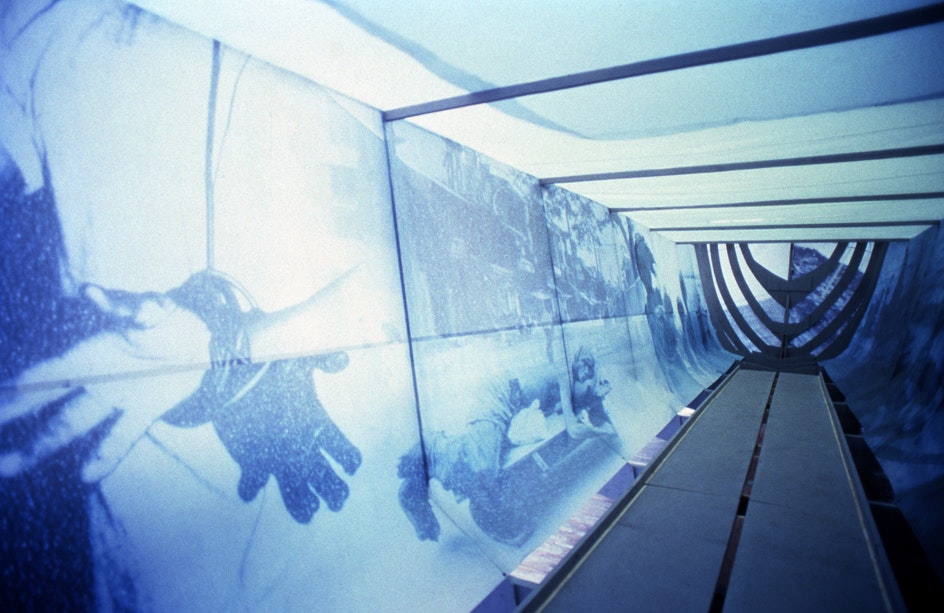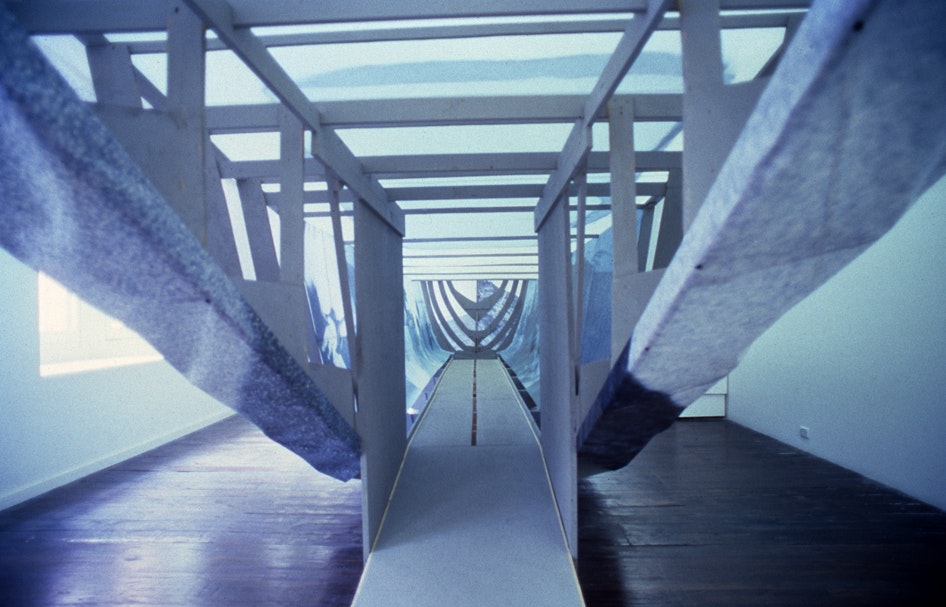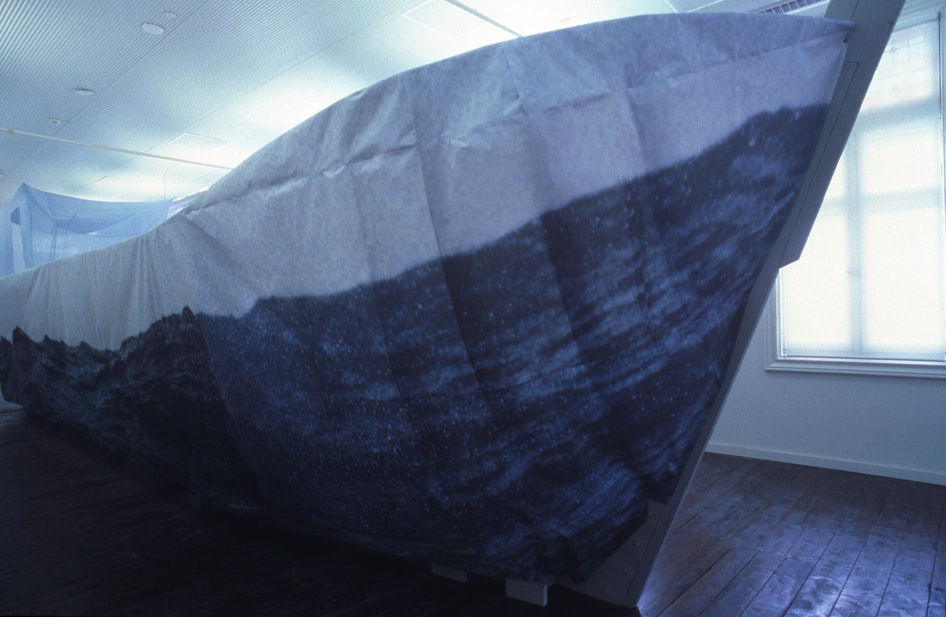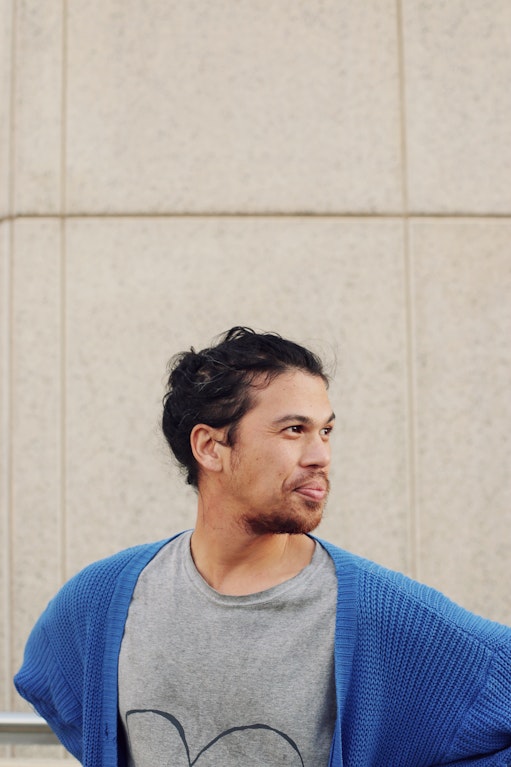The Island Beside the Boat
Gok-Lim Finch

Dacchi Dang’s role as a founding member of what became the 4A Centre for Contemporary Asian Art feels like an act of friendship to me. It is touching to know that people build spaces for you, for them – to step into an identity that you share.
I have never seen The Boat in person. I have seen photographic documentation and a description of a plywood and silk print installation. I know it was 14 metres, the size of the vessel that Dang travelled on when he left Vietnam with his siblings at the age of 16. I know it was a conversation between Dang and other members of the local Vietnamese and Chinese Vietnamese community. I know you could walk through it.
If I were to step inside, I would still be outside of this conversation. Dang and I share a mother tongue, Cantonese. Our grandparents left Southern China during the civil war. Yet I will never feel what it is to have endured the necessary and traumatic journey of survival that he made with his family. I watch an interview where Dang describes how the Vietnamese and Chinese Vietnamese community happily lined up an hour early outside of 4A to take their pictures next to The Boat. I cry as I watch this. I sit with my emotions, tease out the threads. Pride, relief, affection, and guilt – a collection of emotions that could be empathy. I hold them carefully, at a distance. What is described as empathy can sometimes be better described as an attempt to normalise, sublimate, collapse difference.
In a 2013 interview in the journal Interventions,1 the writer Sara Ahmed describes how she learned from Professor Aileen Moreton Robinson’s work that ‘feeling the other’s pain’ can be a violence that projects a narrative onto the other, assumes its emptiness, and stops one from taking steps to redress.2 The Boat is an invitation to witness a witnessing. Although the general narrative can be read by many, the contextual detail of the intimate screen-printed photographs is only available to Dang’s communities.
The Boat frames many layered memories. It reminds me of speaking to my 婆婆, how her stories repeat, and in the repetition change dramatically, like she is holding many interwoven stories at once. For some of these stories, I am on the inside, and for some, the outside.
Dang finds home in the family that he has, and the constellation of different stories we travel through, the way in which this constellation of happenings in our past is swept up into a moving ongoing making of the present.
The multiple identities that make up diaspora hybridity are negotiated, if not entirely mastered, by accepting that the only way forward is to accept that it is only in the small cracks in the dominant culture’s actions and narratives that they will find flaws, find avenues to turn their otherness into a source of self-empowerment.
The Artist as Explorer, Dacchi Dang 2

I am tracing out the ways that I relate to Dang and his work because these relations, echoes of what we are and have done, what family and home mean, are part of my wanting to know, to familiarise myself with, to be intimate with, his work. Intimacy can be a political act. To share silences, to speak with familiarity, to hold someone in your view of the world, to stay with them as your view develops.
The soft focus of the pinhole camera, Dang says, leaves all subjects in frame potentially interrelated. All objects in the frame share focus. Small distortions in the image can be left like clues by the chance circumstances of the development process. In converting a building on Peel Island into a site-specific pinhole camera as part of his 2011 series Lens of the Other, Dang notes that the process of developing a photographic image with this method was about “waiting through time” rather than capturing a single moment. 3 Dang relates this process to the experience of people on Peel Island who were incarcerated or quarantined.
What I’ve learned from observing his work is that time is not linear. It accumulates in our bodies, in buildings and boats, in stories that are waiting to be developed, uncovered in light. Empathy is not about feeling for; it is about staying with.

The building-camera speaks through these images of the boundary between inside its experience and the world outside that it encounters.
If we keep things in soft focus, we can remember the time that The Boat was first exhibited at 4A as a time when the Australian colony asked the crew of the Tampa to leave 433 people to die at sea. Mostly Hazaras seeking refuge during the US invasion of Afghanistan, these people were the first to experience the cruelty of the Australian colony’s indefinite offshore internment. Christmas Island, along with Nauru and other islands, became the first places to be excised from the Australian migration zone. If we wait with this moment through time, we can see the formation of Christmas Island as a phosphate mine in the late 19th century with hopeful Chinese immigrants trapped in indentured labour. We can see the flow of capital from the mine to Australia and New Zealand, the fight for workers’ rights led by Chinese and Malay workers in the 1970s, the building of the detention centre, the WA State premier suggesting the detainment of returning Chinese national students on Christmas Island during the beginnings of the Covid-19 pandemic. We can also see the expansion of the surveillance state, the explosion of Islamophobia, the establishment and growth of refugee activist groups such as RISE: Refugees, Survivors and ex-detainees in 2009.
We remember the heat and the crowds in protest, the minutes of silence where we wait with, we feel with, those living with injustice. It is under this constellation of happenings that we sit now, letting light through the borders between stories, developing a photograph of what must come.
Notes
Endnotes:
1. Phanuel Antwi, Sarah Brophy, Helene Strauss & Y-Dang Troeung, ‘Not without ambivalence’, Interventions, 2013, p. 125
2. Dang, Dacchi. The Artist as Explorer: How Artists from the Vietnamese Diaspora Explore Notions of Home, Griffith University, 2013, p. 183.
3. Ibid, p.161
All images: Dacchi Dang, The Boat, 2001, site installation: timber, pigment print on Japanese paper, silk, 3.5 x 13m., 4A Centre for Contemporary Asian Art, Copyright Dacchi Dang.
About the contributor
Gok-Lim is a writer and artist living on the unceded sovereign lands of the Whadjuk Noongar people.
